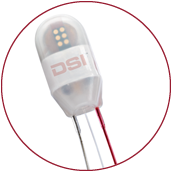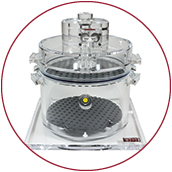It is estimated 936 million adults suffer from obstructive sleep apnea (OSA) worldwide.1 OSA is caused by a relaxation in a patient’s throat muscles, narrowing or closing the airway, and reducing blood oxygen levels.2 This reduction of oxygen can lead to a number of side effects such as decreased sleep quality, hypertension, and metabolic disorders.
OSA is most common in older adults, particularly male patients as they are two to three times more likely than females to develop OSA.2 Additional risk factors for the disease include obesity, genetics, airway structure, congestion, and use of drugs such as alcohol, sedatives, tranquilizers, or tobacco.2
Patients believed to be suffering from a sleep disorder like OSA engage in a sleep study where doctors observe their sleep cycles, movement of the eye, muscle activity, as well as respiratory and cardiovascular endpoints.1
Typical treatment for OSA uses a continuous positive airway pressure (CPAP) machine which blows air into the nose or mouth to keep airways open throughout sleep. When used properly, this treatment method has proven very effective.1 However, many patients struggle to get used to the device and cease use.3 Sleep apnea research is largely focused on understanding the association between sleep apnea and other disorders, identifying additional treatments, and ultimately a cure.
Animal Models of Sleep Apnea
Animal models assist researchers in better understanding OSA and its links to other disorders as well as assessing efficacy of new treatments. English bulldogs have served as an effective model as they naturally experience OSA due to their large soft palate and narrow oropharynx.3 Studies show these dogs often develop OSA even if they are not obese.3 Other animal models can also develop OSA through obesity including minipigs and rodents.3
To induce OSA in experimental models, researchers typically employ intermittent hypoxia. This method is used to replicate periods of hypoxia and re-oxygenation seen in human patients during sleep.4

Sleep Apnea Publications Citing Use of DSI Solutions
The following is a sampling of publications which have used various DSI solutions to study aspects of sleep apnea.
DMSO potentiates the suppressive effect of dronabinol, a cannabinoid, on sleep apnea and REM sleep
Dimethyl sulfoxide (DMSO) can be used to dissolve compounds in preclinical and clinical studies. Recent studies have indicated the cannabinoid dronabinol dissolved in DMSO decreased the frequency of apnea and the amount of REM sleep in a rat model. This study aimed to confirm whether DMSO increased the effects of dronabinol by exposing rats to dronabinol dissolved in 25% DMSO. DSI’s whole body plethysmography (WBP) system was used with electrical commutators to measure EEG, EMG, and respiratory end points simultaneously. The study results contradicted previous findings, failing to decrease apneas. However, they did see a decrease in REM sleep, which was consistent with previous studies. The only difference with this study and those previously conducted was the concentration of DMSO. These results support increasing evidence that DMSO has innate biological activity of its own and is not merely used to dissolve other compounds.5
Oxytocin neuron activation prevents hypertension that occurs with chronic intermittent hypoxia/hypercapnia in rats
Blood pressure and heart rate surges typically occur as a result of the increases in sympathetic activity and decreases in vagal tone post-apnea. As a result, hypertension is commonly associated with obstructive sleep apnea. Recent studies have shown oxytocin (OXT) may reduce cardiovascular responses to stress, and this study aimed to see if the release of OXT from paraventricular nucleus (PVN) fibers in the dorsal motor nucleus of the vagus (DMNX) is reduced with chronic intermittent hypoxia-hypercapnia (CIH/H) exposure, and whether activation of PVN OXT neurons restored OXT release in the DMNX preventing hypertension triggered by CIH/H. DSI’s pressure sensing solutions were used to monitor blood pressure and heart rate. This study indicates PVN OXT neuron activation could be a novel and powerful target to mitigate negative cardiovascular outcomes associated with OSA.7
Impacts of Subchronic, High-Level Noise Exposure on Sleep and Metabolic Parameters: A Juvenile Rodent Model
Noise has commonly been associated with metabolic and sleep disorders, but its effects have not yet been confirmed. This study aimed to assess the effects of exposure to subchronic, high-level noise on sleep, apnea, and homeostasis in juvenile rats. Rats were exposed to noise during their rest period for just over five weeks. Throughout this time, sleep was quantified by measuring EEG and EMG with DSI solutions. The research team also used Buxco WBP to monitor the number and duration of apnea episodes. Although noise exposure did not appear to affect the frequency or duration of apnea, it did cause small but significant sleep disturbances, greater food and water intakes, greater body weight gain, as well as greater thymus and adrenal gland weights.8
DSI Solutions for Sleep Apnea Research
Implantable Telemetry
Implantable telemetry allows researchers to study sleep cycles as well as physiologic responses to sleep apnea. Available endpoints include, but are not limited to, EEG, EMG, ECG, blood pressure, heart rate, and blood glucose. Telemetry allows for continuous measurement in conscious, freely moving animals, improving animal welfare and providing higher quality data than tethered or anesthetized methods.

Respiratory Solutions
DSI’s Buxco research solutions measure various respiratory endpoints and enable apnea detection within the software platform. WBP is the most commonly used solution for OSA research as it allows the animal to roam freely and sleep naturally. It also allows researchers to induce hypoxia and seamlessly integrate other collection methods, such as hardwired or telemetry for physiologic endpoints.

Are you performing sleep apnea research? We’d love to hear what methods you are currently using, what’s going well, and what challenges you face. Schedule a call with us and let’s work together to put together a plan ensuring you get the most out of your experiments.

References
1Benjafield AV, Ayas NT, Eastwood PR, Heinzer R, Ip MSM, Morrell MJ, et al. (2019). “Estimation of the global prevalence and burden of obstructive sleep apnoea: a literature-based analysis”. The Lancet, 7(8), 687-698. https://doi.org/10.1016/S2213-2600(19)30198-5
2Mayo Clinic Staff. (2019). “Sleep Apnea”. Mayo Clinic. https://www.mayoclinic.org/diseases-conditions/sleep-apnea/symptoms-causes/syc-20377631
3Chopra S, Polotsky VY, Jun JC. (2016). “Sleep Apnea Research in Animals. Past, Present, and Future”. American Journal of Respiratory Cell and Molecular Biology, 54(3), 299-305. https://www.ncbi.nlm.nih.gov/pmc/articles/PMC4821036/
4Davis EM, O’Donnell CP. (2013). “Rodent models of sleep apnea”. Respiratory Physiology & Neurobiology, 188(3), 355-361. https://www.ncbi.nlm.nih.gov/pmc/articles/PMC4010146/
5Calik MW, Carley DW. (2019). “DMSO potentiates the suppressive effect of dronabinol, a cannabinoid, on sleep apnea and REM sleep”. bioRxiv. https://www.biorxiv.org/content/early/2019/09/18/769463.full.pdf
6Darwiche W, Gay-Quéheillard J, Delanaud S, El Sabbouri HEK, Khachfe H, Joumaa W, Bach V, Ramadan W. (2018). “Impact of chronic exposure to the pesticide chlorpyrifos on respiratory parameters and sleep apnea in juvenile and adult rats”. PLOS ONE. https://doi.org/10.1371/journal.pone.0191237
7Jameson H, Bateman R, Byrne P, Dyavanapalli J, Wang X, Jain V, Mendelowitz D. (2016). “Oxytocin neuron activation prevents hypertension that occurs with chronic intermittent hypoxia/hypercapnia in rats”. Heart and Circulatory Physiology, 310(11), H1549-H1557. https://doi.org/10.1152/ajpheart.00808.2015
8Bosquillon de Jenlis A, Del Vecchio F, Delanaud S, Gay-Queheillard J, Bach V, Pelletier A. (2019). “Impacts of Subchronic, High-Level Noise Exposure on Sleep and Metabolic Parameters: A Juvenile Rodent Model”. Environmental Health Perspectives, 127(5). https://doi.org/10.1289/EHP4045